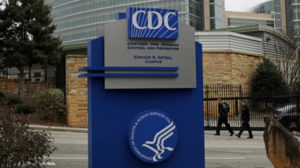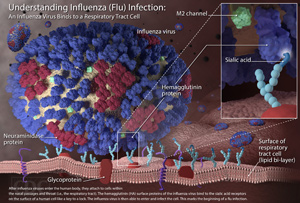Studying human behavior on a large scale has long been used to try to predict how diseases move through a population.
In the latest twist on this principle, your online footprint may offer valuable insight to researchers who are trying to thwart deadly disease outbreaks before they become widespread.

Scientists, frustrated with insufficient prediction models, are more frequently turning to Twitter posts and Google searches to monitor in real time how viruses like seasonal influenza and other communicable diseases may spread.
But it’s complicated. As experts look at everything from local health reports to search engine statistics and complex algorithms, there remains only cautious optimism about progress.
“We think there’s some work still left to do in this space,” said Matthew Biggerstaff, an epidemiologist at the CDC in Atlanta.
Even the newest prediction models remain “way too simple” to forecast transmission, said Jorge A. Alfaro-Murillo, an associate research scientist in the Center for Infectious Disease Modeling and Analysis at the Yale School of Public Health.
How much can we see coming?
CDC scientists are trying to predict flu activity accurately weeks or months before an outbreak.
Since 2013, the agency has organized a seasonal influenza prediction challenge known as FluSight, with external researchers, in an attempt to enhance the predictability potential of flu season.
Each team of flu scientists uses a different method. Some track people’s Google searches, while some evaluate flu-related hospitalizations. Others devise complex mathematical algorithms.

“We’re doing all of this to not only improve our seasonal response, but then understand how we might go about forecasting a pandemic if it occurred,” said Biggerstaff. A pandemic is a worldwide disease outbreak that affects a large number of people.
The goal is to eventually provide a more timely, forward-looking tool that predicts flu activity instead of simply tracking it. Such a tool could improve public health decision-making and allow health officials to be more proactive.
Devising an accurate model will depend on a multifaceted approach, Biggerstaff said. But while the teams have gained new insight from the annual challenge, there’s not a clear signal yet about which model’s predictions consistently deliver the most accurate data.
Following inspiration from the FluSight challenge, a recent study published in the Proceedings of the National Academy of Sciences looked at 22 different flu forecast models and compared them with each other based on their individual performances across seven influenza seasons.
The study found that more than half of the models performed better as compared to a ‘’historical baseline,’’ a model that makes predictions based on past trends.
Despite the findings, the authors of the study believe that their sample size of 22 models is small and not ideal to make strong conclusions about comparative model performance. They conclude that flu forecasting is a continual work in progress, limited by several factors such as data quality, geographical scale of forecasts, weather patterns and population density of the areas under surveillance.
Nevertheless, scientists at the University of Georgia hope an early warning system that they described earlier this year will be able to overcome some of the hurdles.

In a study published online in June in the Journal of Royal Society Interface, UGA researchers looked at the “contagion process,” or the way in which infectious diseases are transmitted. “Some of the ways in which you get new infectious diseases are evolutionary, but there can also be changes in the way that people are responding to being infected,” said John Drake, an author on the study and a research professor at UGA.
The team wanted to understand the tipping point or threshold that indicates if an ecosystem is prone to an outbreak based on factors such as the number of infections caused by a pathogen and how easy it is for the pathogen to be transmitted.
“What we’re interested in is if you can measure how far you are from that threshold based on how many infections you see in a population,” Drake explained. Based on mathematical calculations, the team came up with a formula to measure the approximate distance to the time when the tipping point is likely to turn into an outbreak.
They were able to predict changes in the distance to thresholds that are generally known to change over time, and were also able to demonstrate how those changes could be tracked.
The researchers believe their approach may apply to a range of diseases, including pathogens such as Middle East respiratory syndrome-related coronavirus and vaccine-preventable diseases like measles.
The study is part of a larger project called Project AERO — which stands for Anticipating Emerging and Reemerging Outbreaks — and is funded by the National Institutes of Health to help develop early warning signals for infectious diseases.
Determination tempered with realism
It’s important to note that several mathematical models have been established in the past. So far none offers a perfect solution to the problem of predicting pandemics.
Modeling can be useful, but they are not yet ready for prime time, said Yale’s Alfaro-Murillo, whose research is also dedicated to the mathematical modeling of infectious diseases.

He agrees that the UGA research is interesting and of theoretical value, but says we’re still far from being able to predict an outbreak. A good model should be sensitive enough to differentiate between different diseases occurring in different geographical locations.
The only viable test to prove the appropriateness of a mathematical model is existing data and applying the model to disease cases in real time.
While a usable concept is still distant, researchers are not backing down.
“The truth is we’re not very good at making those predictions,” Drake said. “But sometimes poor predictions are better than no predictions at all.”
Prajakta Dhapte holds a bachelor of science in biotechnology from Bharati Vidyapeeth University and a master’s degree in virology from the National Institute of Virology in Pune, India. Her main interest is in communicating hard science to the general public, with a special focus in infectious disease and public health. She is also a former intern of the The Indian Express, an Express Group newspaper. Dhapte is a graduate student studying health and medical journalism at the University of Georgia.

